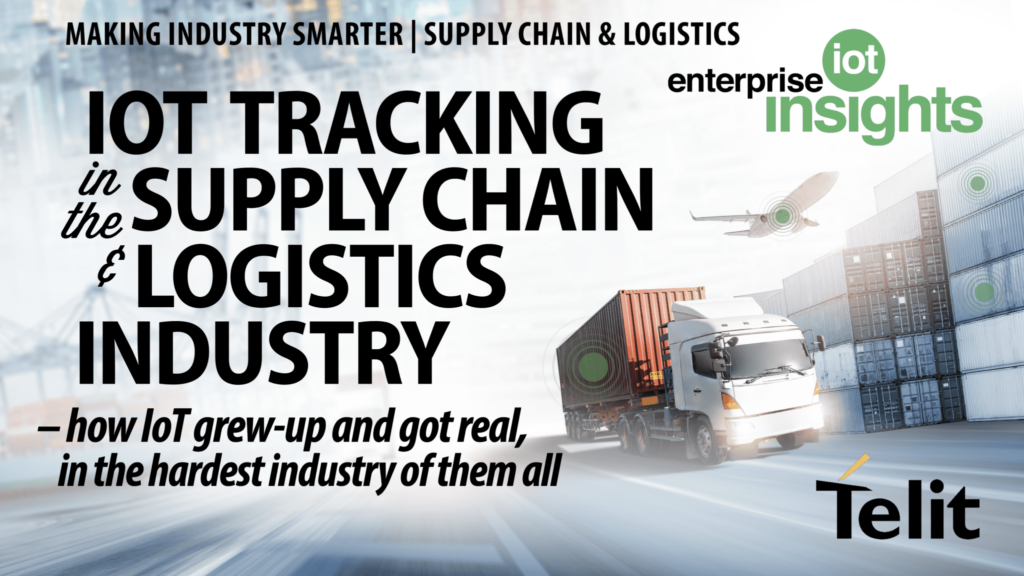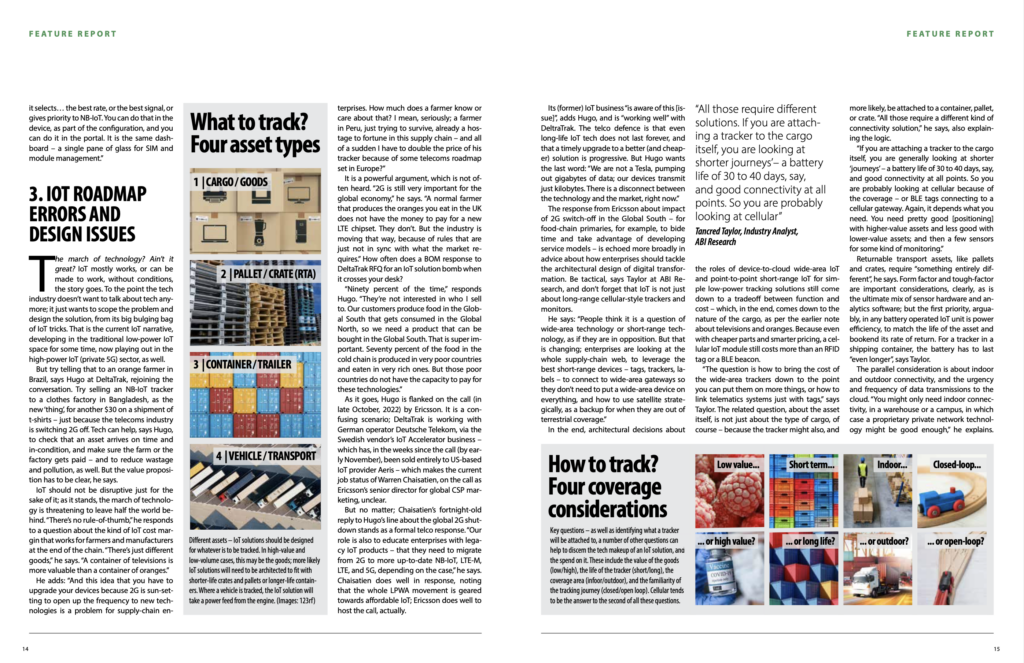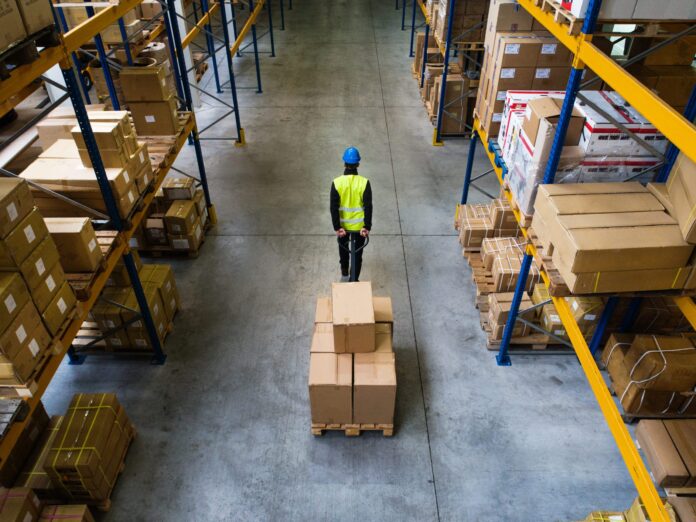Note, this article follows directly from a previous post (January 25) – about how IoT solved the global supply-chain edge, which followed another entry (January 24) about why logistics is the hardest sector of all for IoT; all articles are taken from a new editorial report on the state of IoT in the supply chain sector, released this month (January 2023), and available to download here. The report features additional information, interviews, and case studies.

The march of technology? Ain’t it great? IoT mostly works, or can be made to work, without conditions, the story goes. To the point the tech industry doesn’t want to talk about tech anymore; it just wants to scope the problem and design the solution, from its big bulging bag of IoT tricks. That is the current IoT narrative, developing in the traditional low-power IoT space for some time, now playing out in the high-power IoT (private 5G) sector, as well.
But try telling that to an orange farmer in Brazil, says Erich Hugo at DeltaTrak, rejoining the conversation. Try selling an NB-IoT tracker to a clothes factory in Bangladesh, as the new ‘thing’, for another $30 on a shipment of t-shirts – just because the telecoms industry is switching 2G off. Tech can help, says Hugo, to check that an asset arrives on time and in-condition, and make sure the farm or the factory gets paid – and to reduce wastage and pollution, as well. But the value proposition has to be clear, he says.
IoT should not be disruptive just for the sake of it; as it stands, the march of technology is threatening to leave half the world behind. “There’s no rule-of-thumb,” he responds to a question about the kind of IoT cost margin that works for farmers and manufacturers at the end of the chain. “There’s just different goods,” he says. “A container of televisions is more valuable than a container of oranges.”
He adds: “And this idea that you have to upgrade your devices because 2G is sun-setting to open up the frequency to new technologies is a problem for supply-chain enterprises. How much does a farmer know or care about that? I mean, seriously; a farmer in Peru, just trying to survive, already a hostage to fortune in this supply chain – and all of a sudden I have to double the price of his tracker because of some telecoms roadmap set in Europe?”
It is a powerful argument, which is not often heard. “2G is still very important for the global economy,” he says. “A normal farmer that produces the oranges you eat in the UK does not have the money to pay for a new LTE chipset. They don’t. But the industry is moving that way, because of rules that are just not in sync with what the market requires.” How often does a BOM response to a DeltaTrak RFQ for an IoT solution bomb when it crosses your desk?
“Ninety percent of the time,” responds Hugo. “They’re not interested in who I sell to. Our customers produce food in the Global South that gets consumed in the Global North, so we need a product that can be bought in the Global South. That is super important. Seventy percent of the food in the cold chain is produced in very poor countries and eaten in very rich ones. But those poor countries do not have the capacity to pay for these technologies.”

As it goes, Hugo is flanked on the call (in late October, 2022) by Ericsson. It is a confusing scenario; DeltaTrak is working with German operator Deutsche Telekom, via the Swedish vendor’s IoT Accelerator business – which has, in the weeks since the call (by early November), been sold entirely to US-based IoT provider Aeris – which makes the current job status of Warren Chaisatien, on the call as Ericsson’s senior director for global CSP marketing, unclear.
But no matter; Chaisatien’s fortnight-old reply to Hugo’s line about the global 2G shut-down stands as a formal telco response. “Our role is also to educate enterprises with legacy IoT products – that they need to migrate from 2G to more up-to-date NB-IoT, LTE-M, LTE, and 5G, depending on the case,” he says. Chaisatien does well in response, noting that the whole LPWA movement is geared towards affordable IoT; Ericsson does well to host the call, actually.
Its (former) IoT business “is aware of this [issue]”, adds Hugo, and is “working well” with DeltraTrak. The telco defence is that even long-life IoT tech does not last forever, and that a timely upgrade to a better (and cheaper) solution is progressive. But Hugo wants the last word: “We are not a Tesla, pumping out gigabytes of data; our devices transmit just kilobytes. There is a disconnect between the technology and the market, right now.”
The response from Ericsson about impact of 2G switch-off in the Global South – for food-chain primaries, for example, to bide time and take advantage of developing service models – is echoed more broadly in advice about how enterprises should tackle the architectural design of digital transformation. Be tactical, says Tancred Taylor at ABI Research, and don’t forget that IoT is not just about long-range cellular-style trackers and monitors.
He says: “People think it is a question of wide-area technology or short-range technology, as if they are in opposition. But that is changing; enterprises are looking at the whole supply-chain web, to leverage the best short-range devices – tags, trackers, labels – to connect to wide-area gateways so they don’t need to put a wide-area device on everything, and how to use satellite strategically, as a backup for when they are out of terrestrial coverage.”
In the end, architectural decisions about the roles of device-to-cloud wide-area IoT and point-to-point short-range IoT for simple low-power tracking solutions still come down to a tradeoff between function and cost – which, in the end, comes down to the nature of the cargo, as per the earlier note about televisions and oranges. Because even with cheaper parts and smarter pricing, a cellular IoT module still costs more than an RFID tag or a BLE beacon.
“The question is how to bring the cost of the wide-area trackers down to the point you can put them on more things, or how to link telematics systems just with tags,” says Taylor. The related question, about the asset itself, is not just about the type of cargo, of course – because the tracker might also, and more likely, be attached to a container, pallet, or crate. “All those require a different kind of connectivity solution,” he says, also explaining the logic.
“If you are attaching a tracker to the cargo itself, you are generally looking at shorter ‘journeys’ – a battery life of 30 to 40 days, say, and good connectivity at all points. So you are probably looking at cellular because of the coverage – or BLE tags connecting to a cellular gateway. Again, it depends what you need. You need pretty good [positioning] with higher-value assets and less good with lower-value assets; and then a few sensors for some kind of monitoring.”
Returnable transport assets, like pallets and crates, require “something entirely different”, he says. Form factor and tough-factor are important considerations, clearly, as is the ultimate mix of sensor hardware and analytics software; but the first priority, arguably, in any battery operated IoT unit is power efficiency, to match the life of the asset and bookend its rate of return. For a tracker in a shipping container, the battery has to last “even longer”, says Taylor.
The parallel consideration is about indoor and outdoor connectivity, and the urgency and frequency of data transmissions to the cloud. “You might only need indoor connectivity, in a warehouse or a campus, in which case a proprietary private network technology might be good enough,” he explains. “Or you might need it to roam all over the place in an open-loop supply chain, or track it in case it is stolen, and so, again, you might want cellular.”
Distinctions should be drawn between closed- and open-loop supply chains, where an asset is either travelling with known carriers to known destinations – sometimes even just within an enterprise environment – or else going who-knows-where in the wider world. Short-range IoT is a complete option in a privately-controlled closed-loop environment; a wide-area wireless link is required outside of a private network, in both closed- and open-loop chains.
“You know where the goods are in a closed-loop supply chain, whether they are in your factory or warehouse, or going between, or onto a retailer. You might get away with RFID or BLE tags with a fixed gateway in a closed-loop. You can’t do that in an open-loop, because you don’t know where the goods are, necessarily, and you’re in trouble as soon as you don’t have a reader to read the device. So you need a parent device to get the data to the cloud.”
Taylor explains: “A lot of the focus initially is on connecting internal closed-loop supply chains. Because it is easier to do, and cheaper – just with short-range tags, and maybe a cellular gateway to get the signal out, or with a cellular tracker on every tenth pallet because you are tracking flows, rather than individual assets. An open-loop chain generally requires a wide-area technology, and is much harder and slower to take off.”
That said, some are doing just that; Taylor points to the example of Australian logistics outfit Brambles, parent to pallet-pooling company CHEP, as well as to a digital division called BXB Digital, which is developing proprietary IoT for a global fleet of 360 million pallets, crates, and containers. It has so far deployed 250,000 pallets with “autonomous tracking” in the UK and Canada; another 300,000 are due in North America in the next 18 months.
Helen Lane, chief digital officer at Brambles, says: “We aim to remove the need to think about pallets at all. We will use data to automate processes and predict challenges… [to] enable a frictionless experience. Our ambition is to use the same analytics… to deliver a better-Brambles, to shine a light on our customers’ supply chains… [and] to provide products and services that address shared industry problems.” (A full interview with Lane can be found on pages 24-25 of the report.)
For Taylor, the challenge for the supply chain sector at present is mostly a straight IoT-style exercise, just to connect the dots, crossing over into siloed company systems – even before pulling them together in analytics engines in software dashboards. He says: “Customers don’t have a lot of digitalization in the first place – whether at the edge, or a systems level. So the discipline just now is to string things together, and fill in the gaps.”
The rest of this article appears in a new editorial report, available to download for free here.

